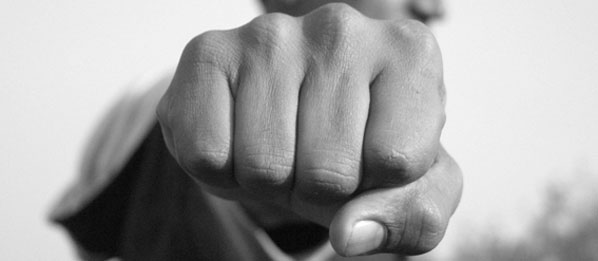Ok, time to for me to nerd out here.
I’ve had this debate many times and have seen and read other debates on which one is a better punch. Most come to the conclusion that the horizontal punch has more power and is therefore the superior punch. As a Taekwondo and Hapkido practitioner I have always been in the middle since Taekwondo makes use of the horizontal punch and Hapkido makes use of the vertical punch. However, as the years go by I’ve slowly transitioned into a vertical punch supporter.
Let’s start with the versatility. Both punches require striking with the first two knuckles. With the horizontal punch, the knuckles will be missed if the punch is directed upward. The vertical punch on the other hand will lead with the knuckles with minimal adjustment that won’t compromise its strength.
Next is how sturdy the punch is. With the horizontal punch, the forearm bones (ulna and radial) cross over weakening the structure as well as placing excessive force on the elbow joint which could lead to injury. Though it’s important to state that for trained martial artists, this is not much of an issue other than possible over use. What’s more important is the energy transfer. The energy of the punch will be greater across the straight path of the vertical punch than the crossing path of the horizontal path.
Lastly, and most importantly, is power. There are two things to think about when it comes to power, power generated, and power transferred. Since the horizontal punch has an additional rotational movement, it definitely generates more power. However, what tends to be forgotten on this argument is the fact that the rotation of the punch doesn’t begin until the very end of the punch. This is fine if you punch the air, but is negated when striking an object since you don’t strike the object at the end of your punch. The punch is to strike the object at about 75% of the full extension, therefore there is no rotational power applied. This leaves me with the conclusion that there is no power difference between the two punches.
So, since there is no power difference and the vertical punch is more versatile and a sturdier punch, then this leaves me believing the vertical punch is the better punch. However, I would like to point out that I still teach the horizontal punch as the primary punch to my Taekwondo students. There are a couple reasons. One, we punch the air during our forms and it makes a nice pop. The second reason is a little more useful, it’s considered to tear skin. When the punch is delivered, the twisting motion of the punch is believed to tear skin to create more damage.
More Myths and Misconceptions about Martial Arts
Part I – Martial Arts are all about Fighting
Part II – Sport vs. self-Defense
Part III – Size and Strength are of no importance in Martial Arts
Part IV – Horizontal Punch vs. Vertical Punch
Part V – Dim Mak (pressure points)
Part VII – My martial art is better than your martial art
Part VIII – The Hook punch is the most powerful punch you can throw







What medical science supports the radial bone crossing over the ulna weakens the structure? You’re aware that engineers often build cross-beams to amplify the support of the structure right?
I prefer the vertical punch when engaging in the initial distance, as all I’m interacting with are the hands and feet. If I have to grapple or parry the arms, my hands are already oriented to align with the horizontal plane of the limbs, directing their attacks way from me. In addition, if you watch the elbow of a horizontal punch that comes out 75% through, you’ll notice the elbow rotate. This can be problematic as we’re introducing new joints in different directions of momentum, leading to greater chances of error, and therefore injury. In addition, any direction you move is generating a force, or energy, and the more directions your body moves, the less energy you’re directing into the strike.
Where I see the horizontal punch shine is when you’re closer and have an opening for the face. Soft tissue with the twisting, a wider attack surface on a target who’s only real options are going backward, going downward, going left, going right, or some combination thereof. If you are close enough to hit their face, it is more advantageous to have a horizontal attack surface than a vertical, to cover the likely degree of movements of left and right.
I actually know engineering and structural steel quite well. My first career was detailing (drawing) structural steel for commercial buildings. Though its been a number of years. I’d have to check my manuals, but if I recall correctly, cross bridging on joists are only to stabilize the joist from rotating. We only used cross bridging when the joist was extra tall. The top of one joist would bridge to the base of the next. Even when using cross bridging we also used straight bridging on the ends and occasionally between the cross bridging. Primarily we used straight bridging as it is better at stabilizing the joists as a whole and better at transferring energy. Nonetheless, what I believe I was speaking of in the write up had more to do with the joints. The twisting of the ulna and radial bone force an angle into the joint. While it’s highly unlikely to lead to an injury, especially from a trained puncher, it suggests to me that power is lost at that joint from the twisting. The vertical punch maintains the bone alignment, and therefore should have the least amount of energy loss. Hope that clarifies what I was writing. It’s been years since I wrote that. Tough to remember what all I was thinking at the time.
Note, I should have called the “horizontal punch” a “corkscrew punch”. Horizontal may suggest that the punch can start horizontal and stay that way, which would place the elbow 90 degrees from the body. Whereas the corkscrew punch would start palm up at the arm pit and twist at the end of the punch.
Thanks for the comment!
Cross beams in building structures are actually connected giving them more strength. There is no physical way to touch each bone to the other in the forearm.
Excellent article.
I did some research on this too and in boxing prior to the introduction of boxing gloves in the late 1800’s, bare knuckle boxers used a vertical fist. With the introduction of gloves, boxers no longer caused the same damage with their knuckles, so introduced the turning wrist so that the leather of the glove “stuck” to the skin to try and tear it – as you alluded to above.
It wouldn’t surprise me if eastern martial arts were influenced to used horizontal fists from the introduction of western boxing.
I changed to vertical punches after I was doing heavy bag work without gloves. Its becomes very evident under those circumstances that the horizontal punch has much less structural strength and the point of contact for the exact reason you say – you are starting to turn at the point of contact which introduces weakness into the wrist structure and it is very easy to roll your wrist. So removing the wrist turn reduces the risk of injury and it also allows you to apply full force into the strikes. Due to the risk of injury from a rolling wrist I was unable to hit with the same strength with a horizontal punch.
Unless you’re doing this on a heavy bag you probably won’t notice as if you are sparring you are normally not hitting full power and also its less likely to roll your wrist on a person than a bag. Just my two cents but based on practical application and making alot of mistakes.
Great comparison of horizontal and vertical punches! The breakdown of pros and cons for each technique is really helpful for improving form and effectiveness in martial arts. Thanks for sharing!